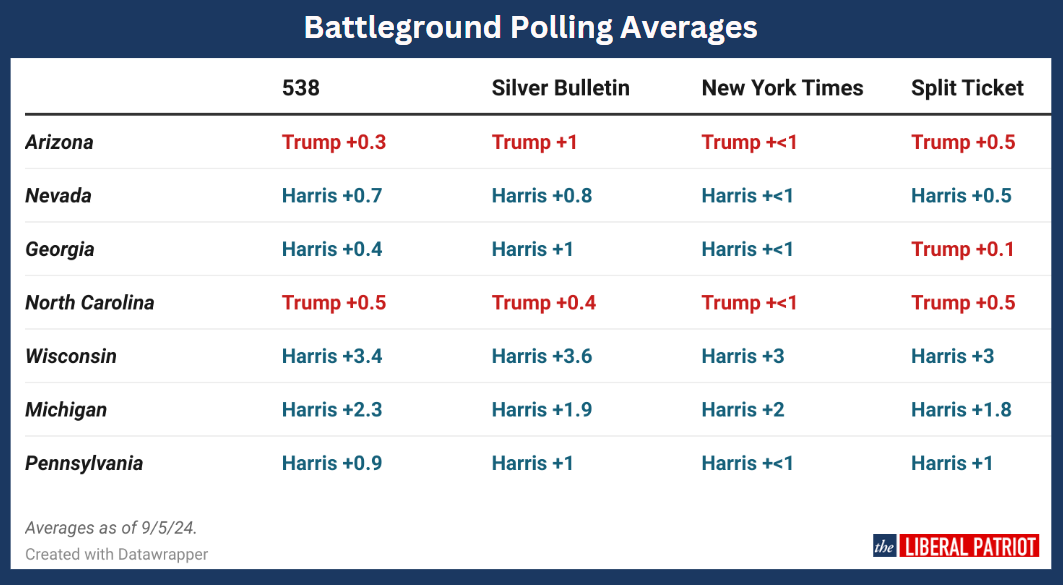The Election is Really, Really Close
Don’t buy overconfident partisan narratives—this will likely be a photo finish.
Talk to a highly-engaged, partisan Republican or Democrat these days and you might find that each is convinced their side is bound for the White House. Democrats have been on cloud nine since the July candidate swap. Kamala Harris’s favorable ratings have risen dramatically from -15.7 on net (favorable minus unfavorable) the day before Biden dropped out to -0.4 after Labor Day weekend. Democratic enthusiasm, too, has surged. Gallup finds that a whopping 78 percent of Democrats are “more enthusiastic than usual” about voting—a 23 point jump from March. Conveniently ignored in this blue-team cheerleading is the fact that Democrats also led the voter enthusiasm battle in Gallup’s final 2016 reading.
Some Republicans, meanwhile, point to voter registration numbers to find good news for Donald Trump. The GOP have significantly narrowed the Democratic registration advantage in Pennsylvania—a strong sign, some say, that Trump is headed towards a Keystone State win after losing by just 80,000 votes four years ago. It is more likely, however, that this a lagging indicator: these newly registered Republicans have been voting red for many years and just now got around to switching their registration.
Others are “unskewing” polls to build a national lead for Trump. In 2020, Biden led by far more than Harris does now, they argue, so her 3-point national lead actually indicates that Trump is ahead. Polling error, however, is random: a pro-Trump error in 2020 does not portend the same this year.
These partisan narratives—from both Republicans and Democrats—are not particularly convincing. No matter what enthusiasm numbers say here or the registration numbers say there, one thing remains clear: this election is really, really close.
Across polling aggregations, all seven battleground states are within the margin of error. Five of seven are within a single point. Harris’s narrow leads in Wisconsin and Michigan might make her a slight favorite, but adding those to her column still leaves her short of 270.
To Democrats' delight, national polls show Harris opening up a roughly 3-point lead. But this lead is actually also in line with a tight Electoral College. In 2016, the tipping-point state (Wisconsin) went for Trump by 0.8 percent as Clinton won the popular vote by 2.1 percent—a 2.9 point gap. In 2020, Biden won the tipping-point state (again Wisconsin) by 0.6 percent and the nation by 4.5 percent—a 3.9 point gap. Even if we expect rightward shifts in Florida, California, and New York to tighten this popular vote-Electoral College divide, Harris likely needs to win the popular vote by 2-4 points to have a chance at 270.
For fans of cold, hard, real-life election results, the Washington State primary results offer another data point for a close race. Long a favorite tool of election insiders, these August “jungle primary” results have proved an approximate indicator for November’s results. In the 2018 “Blue Wave,” Democrats won the statewide primary vote by 20 points. In 2020, the margin was D+14, and in 2022, a much redder year, D+10.4. With 2024 tallies finalized, Democrats slotted in just above their 2020 performance: D+15.8. These results confirm we are far from any sort of wave—in either direction—and instead headed towards a national environment roughly on par with 2020.
With ballots already headed out to voters, next week’s debate offers one of the last chances for a real shake-up. In the meantime, beware overconfident partisans—in all likelihood this will be a nail-biter.







Problem is, if it really is very close, it’s going to be very ugly. Trump is already casting doubt on the election’s legitimacy in case he loses. And he’s got more minions in the States to help do his bidding.
It doesn't help that our Intelligence Agencies are spreading fears of illegitimate by citing Russia and/or Iran constantly. It keys everyone on all sides to question the results no matter what. However, I mostly agree that there's really no way to be that sure right now. Because I try to think about these things from the viewpoint of someone who doesn't follow politics closely, I always want the side I'm voting for to think they are losing at least a little. Americans can get very lazy if they think everyone else has it covered.